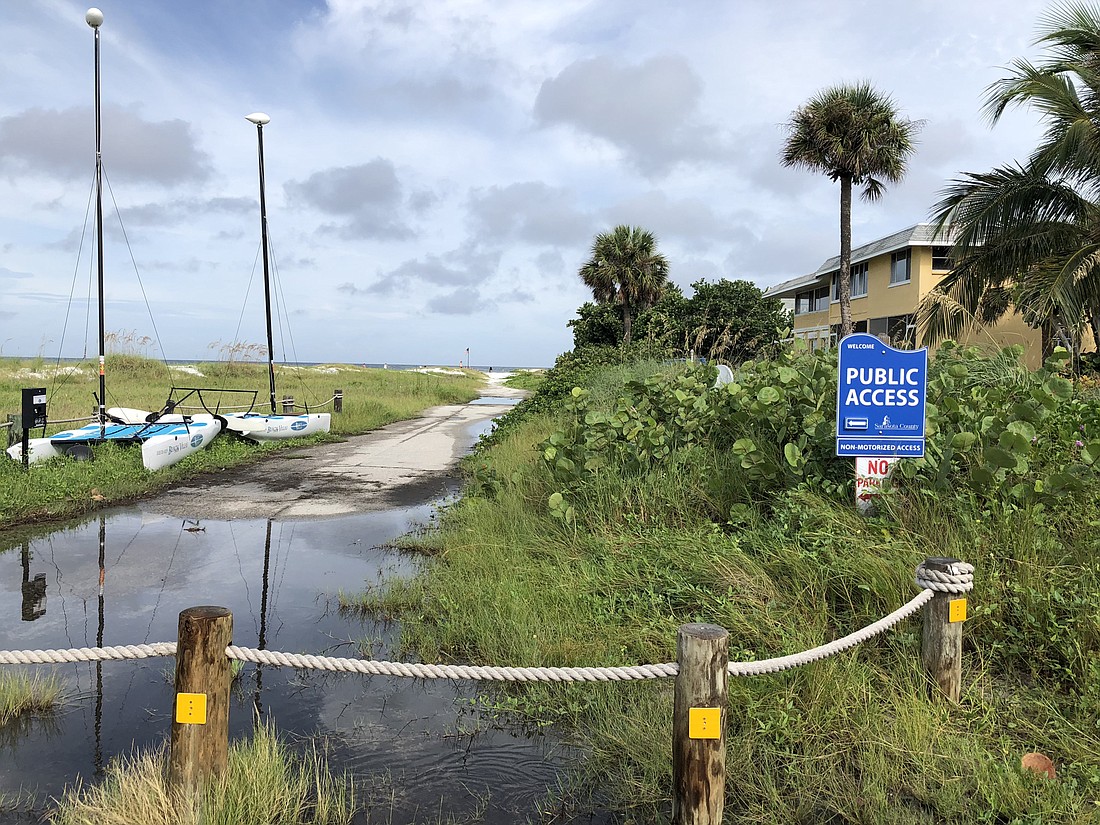- January 14, 2025
-
-
Loading

Loading

Should Sarasota County be able to make changes to rights of way, parks, beaches and beach access? That is at the heart of a question that will be on the local November ballot.

The controversy began with a short stretch of Beach Road near Siesta Village, at the very northern tip of Siesta Beach, which runs right next to the beach for one block from Columbus Boulevard to Avenida Messina.
Back in the 1980s that road was often awash, covered with sand, difficult to maintain and temporarily closed. By the early 1990s the county had closed the road to vehicles. Property owners along that block of Beach Road had access to their properties from the other side, away from the beach. Beach access for the public remained open at both the end of Columbus Boulevard (Beach Access 3) and Avenida Messina (Beach Access 2) (see map).

For years, the road remained closed and uncontroversial. Then in May 2016 the County Commission responded to a request from some of the property owners on that block of Beach Road and vacated that stretch of road. That meant the county agreed not to restore the road to vehicle traffic. In return, access by pedestrians, bikes, etc. would remain open in a permanent easement, as would the existing beach access points. This is the current situation.
Soon after the County Commission decision, however, longtime Siesta Key resident Mike Cosentino objected and launched an all-out effort to get the decision reversed. He claims the decisions violated the county’s comprehensive plan, and he started a group called Reopen Beach Road. He argues the road should be restored to vehicular traffic, and that by vacating the right of way the County Commission took away a public access point, reduced beach access, removed one of the few places you can see the water from a vehicle, and allows the property owners to expand their development of their lots.
In 2017, the 12th Judicial Circuit Court ruled against Cosentino that the closing of the road violated the county’s comprehensive plan. In response, he launched a campaign to gather signatures and has succeeded in getting the issue on our November ballot.
The language of the ballot measure is not yet final, but Cosentino is asking for it to rescind the vacating of the Beach Road right of way and forbidding the county from vacating or selling any rights of way along water in the future.
The County Commission, meanwhile, has insisted the road was not going to ever be useful for vehicle traffic and the deal it made with property owners did not reduce beach access. The property owners expressed agreement.
A walk along the closed stretch of Beach Road makes one wonder what all the hoopla is about. The road runs into the beach near Avenida Messina, so restoring it to vehicles would mean taking a lot of beach away and allowing vehicular traffic virtually to the water’s edge, which I doubt many people want rather than the current walkable stretch of beach. As you can see in the accompanying photo, the right of way is still clearly marked public access, and you can see how the road disappears into the beach.
Reopening the road to vehicles would not stop the beach from encroaching on the road, as it has for decades, hence the county’s decision that it should be closed. Despite Cosentino’s claim, there are a great many places in the region you can see the water from your car, including at the Siesta Beach Pavilion parking lot just down the road.
Moreover, access to the beach is at least as good, if not better, than before the road was closed. Before 2016 it was unclear where the road was, so people parked all over the place, often blocking the path to the beach. After it was closed and everything clearly marked, the beach access functions much better. The mobility-impaired have at least as good access to the beach via Beach Access 2, 3, and 5 as they did before the Beach Road segment was closed, and truly great access at the main Siesta Beach Pavilion parking lot and access point.
The closed segment of Beach Road is still required to be fully available to walkers, bikers, etc., and is very pleasant to use. Road traffic does not need the connection, as Beach Road connects with Columbus Boulevard and Avenida Messina joins a long string of streets on Siesta Key that end at the beach. All of this is probably why the Siesta Key Association, a fierce defender of Siesta Key beaches, was not moved by Cosentino’s presentation and declined to support the effort.
So the ballot proposal won’t fix anything that is broken. By all objective standards, the deal the County Commission made improved a difficult situation for beachgoers, the public and property owners. Worse, some of the language that has been proposed would prevent the county from ever making land trades or moving or removing rights of way no matter how much sense they might make in the future.
When expanding or improving parks or boat ramps or beach access, sometimes the county makes deals with landowners to trade rights of way, or vacate or preserve access in various ways, trying to shape things to allow the best design of access, parking and recreation. If we tie the County Commission’s hands forever by locking in all current rights of way along water, we are assuming nothing will ever change, which is demonstrably the opposite of what is true.
One man’s passion, however heartfelt, should not undo an arrangement so obviously good for the general public, nor prevent the county from making future decisions to improve the use of rights of way.
Adrian Moore is vice president at the Reason Foundation and lives in Sarasota.